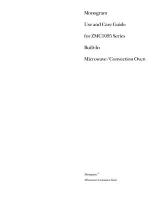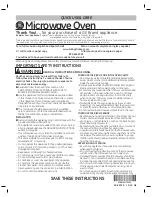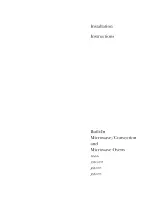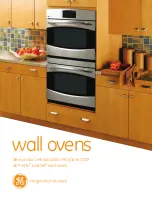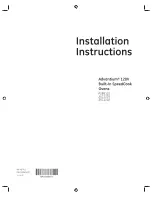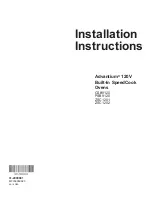
- Eng-5 -
Precautions for Placement and Cooking
(continued)
Warning
(a) In the event that the oven door or door seal has been damaged, do not use the oven until a qualified
technician has repaired it. Do not damage the safety lock of the oven door, including the door hinges.
To repair the product, please contact an authorized Service Center by Panasonic.
(b) Except for a qualified technician, repair work is very dangerous. Do not attempt to disassemble, repair
or modify the oven yourself.
(c) Do not allow children or someone without knowledge of oven operation to use the oven in an
unattended manner unless they get proper instructions on use and know that any improper operation
may lead to danger.
(d) Do not use a rough scrubbing tool or sharp metal scraper to clean the oven door glass; otherwise the
glass will be ruptured.
Wiring Requirements
1. The oven must be operated on a SEPARATE
CIRCUIT. No other appliance should share the
circuit with the oven.
If it does, the branch circuit fuse may blow or the
circuit breaker may trip.
2. The oven must be plugged into at least a 15 A
or 20 A, 120 V, 60 Hz GROUNDED OUTLET.
(Beginning in 2017, all new construction and
all renovated single family homes must have
at least a 20 A, 120 VOLT, 60 Hz GROUNDED
OUTLET). Where a standard two-prong outlet is
encountered, it is the personal responsibility and
obligation of the consumer to have it replaced
with a properly grounded three-prong outlet.
3. The VOLTAGE used must be the same as
specified on this oven (120 V, 60 Hz). Using a
higher voltage is dangerous and may result in
a fire or oven damage. Using a lower voltage
will cause slow cooking. Panasonic is NOT
responsible for any damages resulting from
the use of the oven with any voltage other than
specified.
Precautions for cooking
1. Cautiously take out heated liquid foods such as
soups, sauces and beverages. Pay attention to
the following items during cooking:
(a) Prevent over-heating; otherwise the liquid may
suddenly boil and splash to scald you when
you take out the food.
(b) When you heat liquid food, the liquid should
be loaded to at least eighty percent of the
container capacity; otherwise a small amount
of heated liquids may suddenly splash due to
boiling.
(c) Stir the food before or during the heating.
(d) After heating, keep the food in the oven for a
while, stir it slightly, and then take it out.
(e) After you use a milk bottle or heat baby food,
stir the food or shake the bottle, and check the
temperature before feeding your baby so that
he or she may not be hurt.
2. Using a common thermometer is forbidden.
You must use a meat thermometer to check the
cooking effect. If cooking is insufficient, place the
food into the oven again for further cooking.
3. Cooking recipes provide the cooking time for
reference. A lot of factors may affect the cooking
time, including the desired degree of cooking,
starting temperature, portion, size, food shape
and container type. If you are familiar with
product operations, you can properly adjust the
cooking time by referring to the above factors.
4. When using the Conv. Bake function, you must
control the cooking time and pay attention to the
heated food all times. Over-heated food may lead
to smoke or fire.
Exterior oven surfaces, including air vents on the
cabinet and the oven door will get hot during Conv.
Bake. Use care when opening or closing door and
inserting or removing food and accessories.
Caution! Hot surfaces
Fan Motor Operation
After using the oven, the fan may rotate to cool the
electric components and “
” rotates in the display
window. You can take out the food from the oven
while the fan operates. It is recommended to keep the
oven plugged in until the Fan Motor completely stops
operating.
SAVE THESE INSTRUCTIONS
For proper use of your oven, read remaining safety cautions and owner’s manual.
F0003CF00AP_EN_20220122.indd 5
F0003CF00AP_EN_20220122.indd 5
2022/1/22 14:30:47
2022/1/22 14:30:47





















